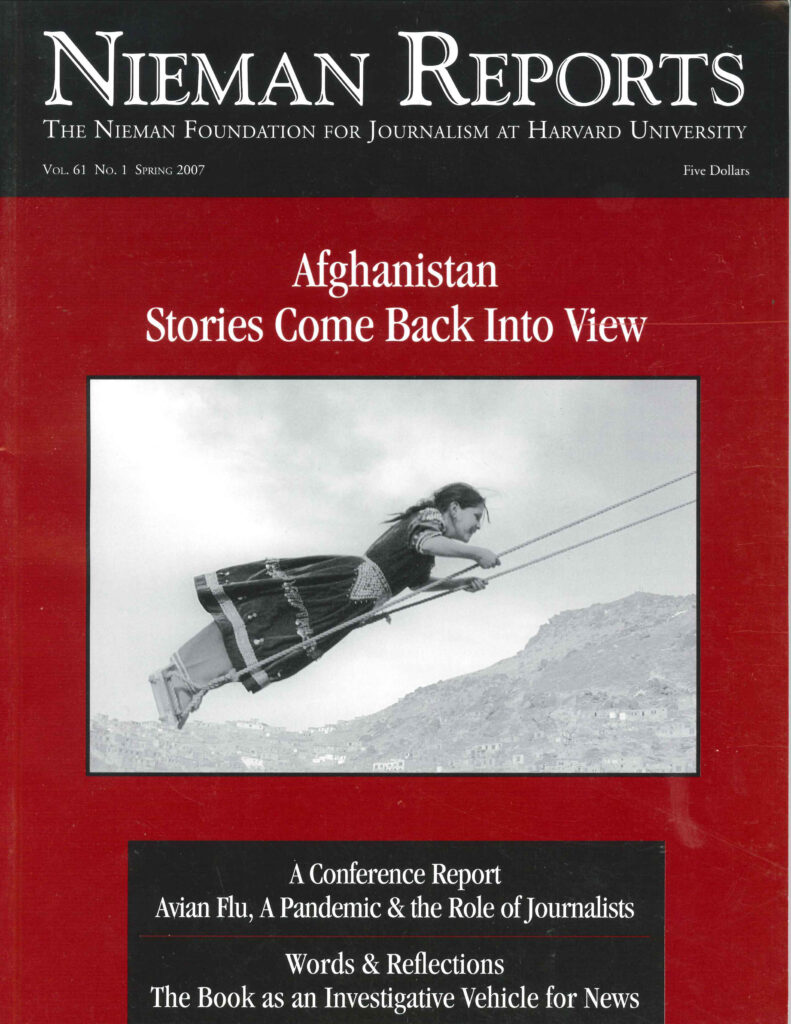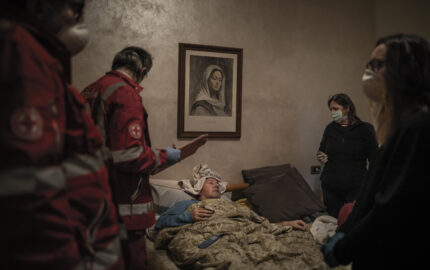
By early 1998, the [Taliban] militia was ready to announce its plan to build a regular national army of two divisions that would replace the tribal and regional task forces. Air assets were to be reorganized in a corps at Khwaja Rawash air base. U.S. officials were aware of the army reorganization at the time, but bin Laden's deepening links with the Taliban leadership escaped notice. "I don't think we saw or understood his connection with Mullah Omar," the CIA station chief in Islamabad would later say. "I don't think we understood exactly this whole role of the reorganization until later." The main reason for overlooking the development was that "we weren't focusing on ... what was going on at the battlefield.... We were focusing on where is bin Laden today."
For journalists on the ground, the first sign of significant change was a clampdown on frontline access. Through most of 1997, the handful of foreign reporters in Kabul was welcomed, even invited, to tour the frontlines. "We would chat with the Taliban, drink tea, and look at the front," recalled Agence France-Presse's Stefan Smith. Sometimes the information minister, Amir Khan Muttaqi, would knock on their doors in the morning and invite them for a drive. In August 1997, the acting deputy minister of information cautioned reporters to send reports that "truly reflected the situation" and not to resort to analysis or witness reports that might give "a false impression" of the situation, the UN reported. The atmosphere worsened in early 1998. Checkpoints were set up to block them from the front unless the visits were organized in advance.
The apparent reason was that Arabs began to play a more important frontline role. "We regularly spoke with travelers coming from villages north of Kabul, who told us about foreign fighters who had taken over large sections of the frontline," Smith said. In Kabul, they spotted Arabs from Yemen, Algeria, Saudi Arabia, Kuwait and other countries as well as Muslims from Chechnya and Burma, even though the Taliban supposedly had asked them to stay out of sight. Three training camps in the Kabul area — in Shakardarah, about 12 miles to the north on the road to Charikar, a second in Paghman, and a third just south of the Darul Aman Palace to the southwest of Kabul — became a "no-go."
"But we knew what was going on there from a whole variety of sources — the military training of foreign fighters," Smith said. Khost became off-limits. In areas around Jalalabad, near the city reservoir, and at Tora Bora also became "no-go areas." Reporters were also discouraged from visiting Kandahar. And the warnings were unmistakable that writing about foreign fighters was not permitted. "The slightest mention even of a Pakistani would get you in enormous trouble," Smith recalled. "I had the general impression that I was on the verge of expulsion." By the summer of 1998, the tension was indescribable. The Taliban gave the impression "that they were starting to resent, if not hate, the few expatriates left in Kabul. Our lives were restricted. REFERRED ARTICLE
"Strategizing to Cover the Afghanistan Story"
– Roy GutmanOur reporting was restricted. We started to need to have bits of paper to do anything," Smith said. [See referred article for details about restrictions.]
These pressures on the international press also indicated creeping Arabization. The Taliban developed a plan to move all foreigners — the UN staff, nongovernmental organizations and charities, and foreign reporters — into the Kabul Polytechnic, the university quarter largely destroyed during Massoud's battles with the Hazara. Reporters were told that the pressure for the move came from Kandahar, inspired by the system in Saudi Arabia, where all expatriates live in compounds. Although the scheme never went anywhere, "it reinforced the impression that we were not really welcome," Smith said. "The Taliban as I had known them from when they arrived in Kabul were no longer the same people. They stopped caring about what the rest of the world thought of them, which was a dangerous direction."
For Osama bin Laden, 1998 presented a window of opportunity to strengthen his ties with the Taliban as well as pursue his own agenda. He slowly raised his profile as he carefully laid the groundwork for a spectacular debut as world actor. His first move was to unite the different factions of Islamists who had drifted apart in the years since fighting the Soviet Union, in particular his own al-Qaeda and Ayman al-Zawahiri's Egyptian Islamic Jihad, and lead them in a new jihad, this time directed against the United States. He set out his political aim in a blood-curdling fatwa that twisted the facts and Islamic theology into his service. Claiming that the United States was "occupying" the Arabian Peninsula in the service of Israel and had killed one million Iraqis, it declared: "The judgment to kill Americans and their allies, both civilian and military, is an individual duty of every Muslim able to do so and in any country where it is possible .... We, in the name of God, call on every Muslim who believes in God and desires to be rewarded to follow God's order to kill Americans and plunder their wealth wherever and whenever they find it."
Dated February 12th, with the subtitle "a legal fatwa," and first published 10 days later in the London-based Arabic newspaper, Al-Quds Al-Arabi, it received almost no other media notice at the time ....
In the first half of 1998, bin Laden had organized his political allies, spelled out his political aims, laid the theological ground for the violence that would follow, and received the endorsements from ulema in Afghanistan, Pakistan and Saudi Arabia. By late May 1998, training for the operation was well under way, and he decided to stage a series of news events at the al-Badr camp in Khost Province. In the first interview — actually more of a monologue — with Pakistan journalist Hamid Mir in mid-May, bin Laden stated that his goals were to expel the U.S. military presence from Saudi Arabia and to "liberate" the Haram al-Sharif in Jerusalem — a 35-acre complex including the al-Aqsa mosque that constitutes one of Islam's most sacred sites but that sits above the Wailing Wall, one of Judaism's most sacred sites — as well as Palestine. Sketching out a megalomaniac vision, bin Laden declared that jihad to liberate "all the holy places of Islam" was "obligatory upon every Muslim" and warned that anyone "refuting the call to join jihad anywhere in the world is an infidel."
Ten days later, he invited a group of mostly Pakistani journalists for a briefing, smuggling them into Afghanistan on a two-day trip, which involved a five-hour trek at night across the mountains, then hours in jeeps, an overnight in a safe house, then a circuitous route before reaching the Khost camp. "Heavy guns boomed as bin Laden peeped out of his sturdy jeep with tinted windows, and rocket launchers were fired in the air to celebrate his arrival," wrote veteran Afghanistan-watcher Rahimullah Yusufzai, who later discovered that most of the gunners were not bin Laden's men, rather Afghans and Pakistanis staying in the nearby Zhawar camp.
Bin Laden's message to the 13 Pakistanis and one Chinese journalist was that the ulema of Saudi Arabia and elsewhere had issued a fatwa to wage jihad "to expel the Jews and the Christians from the Arabian Peninsula." The campaign would also topple the ruling Saudi dynasty, and the members of the royal family would be put on trial after they were overthrown. The result of his latest campaign will "be visible in the coming weeks."
Two days later, he hosted John Miller of ABC News. Citing his fatwa, he told Miller that civilians would be the targets for his next operation. He foresaw an apocalyptic outcome. "We predict a black day for America and the end of the United States as United States," he said, and that the leadership of Saudi Arabia "will disintegrate." Bin Laden "put a time cap on it, saying that whatever action will be taken against Americans in the Gulf, whatever violence awaits, will occur within the next few weeks," Miller reported. Bin Laden had raised his profile, though he claimed he was operating within the Taliban guidelines. The rule was he had been "asked to avoid" military activities, but there was "no restriction" on political activities.
That wasn't the understanding of Mullah Omar, who first learned of the press conference from BBC Radio. He telephoned Yusufzai, who had reported the story for the BBC: "Who was the organizer? How did he travel into Afghanistan without a visa?" The reporter explained the route, and Omar exploded: "How dare he hold a press conference without asking my permission!" He then dictated a statement to Yusufzai. "There will be one ruler in Afghanistan, either I or Osama bin Laden .... I will see to it." Bin Laden responded with a statement that he accepted Omar's rule and leadership, that he accepted Taliban decisions, and promised to abide by the pledge. For several months, he did, more or less.
Neither of these media events received much U.S. media attention or public expression of concern by the White House, U.S. State Department, or Congress.... U.S. authorities and the American media in their one-dimensional focus failed to recognize that bin Laden, the international terrorist, was the same as bin Laden, the Taliban ally, and that the two roles reinforced each other. Bin Laden was not conducting his own military operations, just yet. The logic of his investment in the Taliban domestic war machine, combined with Mullah Omar's sensitivity, dictated that the timing for his own major international military operation should coincide with that of the Taliban.


